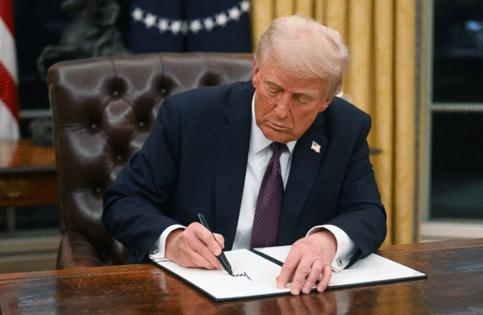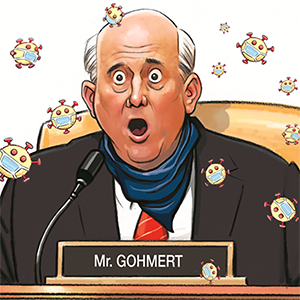Why Donald Trump's legal strategies are working -- some of the time
Published in News & Features
When President Donald Trump decided last month to send the California National Guard to Los Angeles over the objections of Gov. Gavin Newsom, many political and legal watchers were certain that courts would view the move as illegal, a belief that was quickly shattered when a panel of appellate judges appointed by presidents from both political parties ruled unanimously in Trump’s favor.
But the judges were responding to a carefully crafted argument on the part of Trump administration lawyers that showcased wording in the law governing the deployment of the Guard for federal purposes, as well as a Supreme Court decision from 1827 that gave the president the power to decide when a call-up was required.
Those arguments over a temporary restraining order in the ongoing case of Newsom v. Trump, as well as the administration’s approach in a case defending its executive order restricting birthright citizenship, shed light on Trump’s strategies for backing up his barrage of executive orders, many of which appear to run counter to decades of law and precedent.
Bit by bit, incremental wins on the cases can add up to powerful precedents. The National Guard case is expected to be back in court this month, as lawyers for Trump and Newsom spar over evidence that California is requesting from the federal government.
The strategies harness years of conservative legal scholarship while also reaping the benefits of hundreds of judicial appointments by Republican presidents that have increased the pool of judges more likely to be sympathetic to the administration’s arguments.
“There’s no question Trump is lawyered up in this term and has lawyers thinking about defending his moves before he makes them,” said Leslie Gielow Jacobs, a professor of constitutional law at the University of the Pacific McGeorge School of Law in Oak Park. “They’re definitely strategizing.”
The White House’s approach is grounded in the work of conservative academics who, for the past several decades, have looked at using legal tools to reshape the power of the presidency, change the application of civil rights laws and influence American culture and education, said J. Clark Kelso, a government and justice system expert who teaches at McGeorge.
“These are issues that quite a few conservative scholars have been writing about for decades,” Kelso said.
Court cases pursued by Trump and conservative lawyers in recent years have led to a body of decisions that have had the effect of limiting the power of judges over the president and increasing the executive’s control over many government decisions, Kelso said.
Such arguments were made in the National Guard case, as well as the landmark Supreme Court decision last year in Trump v. United States, which said that the president was immune from criminal prosecution for the performance of official acts.
That culminated in last week’s Supreme Court decision in Trump v. CASA, which stopped the enforcement of a preliminary injunction imposed by a lower court on the president’s executive order denying U.S. citizenship to the children of undocumented immigrants, Kelso said.
As part of its appellate strategy, the Trump administration did not ask the court to rule on the merits of the executive order itself. Instead, it requested a ruling only on the question of whether a federal judge can issue a so-called universal injunction against presidential actions, knocking down an order for the entire country rather than just affecting people who have sued.
In its 6-3 decision, the court severely limited the use of universal injunctions. Kelso said the decision effectively increased the power of the presidency.
That success, which is certainly not universal in cases involving actions by the administration, came about partly because of its lawyers’ strategy, but also because over the years, Republican presidents have appointed numerous judges who are sympathetic to it, said Gielow Jacobs. During his first term, Trump appointed more than 200 judges to the federal bench, according to the Pew Research Center.
“There are judges in place that are willing to listen to those arguments and adopt them,” she said.
Sacramento criminal defense attorney Mark Reichel, who has argued before the Supreme Court as well as the 9th Circuit U.S. Court of Appeals, said he thinks the appointment of so many conservative-leaning judges has had a greater influence than any legal strategy developed by the White House.
“Both sides spend hundreds of hours considering all the different ways to prevail,” he said. “And, yes, it is really strategic.”
But the biggest factor at play, particularly at the nation’s highest court, is the rise in judges who are inclined to agree with the administration’s arguments and approach, Reichel said.
“There’s never been such an advantage with a Supreme Court like this,” Reichel said, referring to the high court’s makeup of six conservatives — three of whom were appointed by Trump — and three liberals. “This is the most partisanship you could ever imagine.”
‘Mixed bag’ of success and failure in court
But, overall, said UC Davis School of Law professor Vikram Amar, judges are making decisions based on the law, awarding the Trump administration a “mixed bag” of success, depending on the case.
In the National Guard case, Trump prevailed in arguments regarding a temporary restraining order because his argument was grounded in law and precedent, Amar said. Yet in cases involving Trump’s executive orders aimed at punishing law firms, including revoking their security clearances, the administration has repeatedly lost, he said.
“They’re winning when the law is on their side and they’re losing when the law is not on their side,” Amar said.
Trump’s executive order ending affirmative action or diversity, equity and inclusion programs in federal contracting is an example of a dramatic action that was grounded in the power that the president does hold under law, said UC Davis law professor Gabriel “Jack” Chin.
A federal appeals panel in March struck down a temporary injunction that a district judge had imposed on the order, saying that the government had persuaded them that it should be allowed to carry out the order while a legal challenge played out. The ruling was unanimous, even though two of the judges wrote separately that “people of good faith who work to promote diversity, equity, and inclusion deserve praise, not opprobrium.”
Winning through losing
But Chin said that the administration does not expect to win every case or even necessarily most cases.
“There’s gonna be some dramatic executive orders that are clearly going to be legal, there are going to be some in the gray area and some that are most likely illegal,” Chin said. “In some cases, they are going so far that they expect to lose.”
But, he said, advancing an extreme position can lead to strategic gains even if the overall case is lost.
“There is this concept of winning through losing,” Chin said. “That if you have a couple of extreme positions maybe it makes your other positions look less extreme.”
A case in point is Trump’s executive order on birthright citizenship, Chin said. The order itself is viewed by many scholars, including conservatives, as conflicting with the 14th Amendment, which says that “all persons born or naturalized in the United States and subject to the jurisdiction thereof, are citizens of the United States and of the State wherein they reside.”
Legal scholars said Trump could ultimately lose over the order. But presidents of both parties have been frustrated by universal injunctions that stop their orders nationwide. And by asking the Supreme Court to rule not on the merits but on whether district courts can issue universal injunctions, the administration gained a powerful advantage — making it more difficult for opponents of an executive order to block its enforcement as the court battle plays out.
“So wasn’t that smart,” Chin said. “They’re definitely being strategic.”
____
©2025 The Sacramento Bee. Visit at sacbee.com. Distributed by Tribune Content Agency, LLC.







Comments